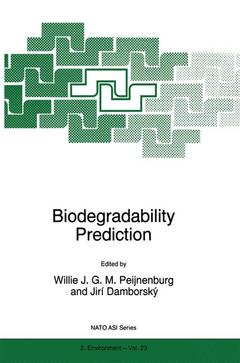Description
Biodegradability Prediction, 1996
NATO Science Partnership Subseries: 2 Series, Vol. 23
Coordinators: Peijnenburg W.J., Damborský Jirí
Language: English
Subject for Biodegradability Prediction:
Keywords
Bioremediation; Dioxin; biotechnology; contaminants; development; hazard; reaction; terrestrial pollution
Publication date: 10-2012
143 p. · 16x24 cm · Paperback
143 p. · 16x24 cm · Paperback
Description
/li>Contents
/li>
Biodegradation is the dominant pathway for the environmental transformation of most chemicals and information on a chemical's biodegradability is essential for proper risk assessment. But there are few methods for predicting whether or not a chemical is biodegradable, since this depends on the chemical's structure as well as on the environmental conditions that it encounters.
The present book deals with quantitative structure-biodegradability relationship models (QSBRs), emphasizing the biological and ecological part of the biodegradation process. Surveys are given of the microbial aspects of biodegradation and the methods available for testing biodegradability. New trends and methods in biodegradation modelling are reviewed, including contributions on computerized biodegradability prediction systems. Some of the newly developed models for assessing risk and ecological impact in aquatic and terrestrial environments have been validated, and this process is discussed.
Audience: Scientists active in microbiology, the environmental sciences, biotechnology and bioremediation. Policy makers will find the book indispensable in assessing the present state of the art on the biodegradability of substances.
The present book deals with quantitative structure-biodegradability relationship models (QSBRs), emphasizing the biological and ecological part of the biodegradation process. Surveys are given of the microbial aspects of biodegradation and the methods available for testing biodegradability. New trends and methods in biodegradation modelling are reviewed, including contributions on computerized biodegradability prediction systems. Some of the newly developed models for assessing risk and ecological impact in aquatic and terrestrial environments have been validated, and this process is discussed.
Audience: Scientists active in microbiology, the environmental sciences, biotechnology and bioremediation. Policy makers will find the book indispensable in assessing the present state of the art on the biodegradability of substances.
Introduction, Main Conclusions and Recommendations of the Workshop `QSAR Biodegradation II'; W. Peijnenburg, J. Damborský. Part I: Biodegradability (foundations, testing). Biodegradability of Xenobiotic Organic Compounds Depends on their Chemical Structure and Efficiently Controlled, and Productive Biochemical Reaction Mechanisms; R.-M. Wittich. Biodegradability Testing of Xenobiotics; P. Pitter, V. Sýkora. Part II: Biodegradability Modelling (trends, methods). The META-CASETOX System for the Prediction of the Toxic Hazard of Chemicals Deposited in the Environment; G. Klopman. Application of Artificial Intelligence in Biodegradation Modelling; D. Gamberger, et al. Polychlorinated Dibenzo-p-Dioxins in Anaerobic Soils and Sediments. A Quest for Dechlorination Pattern-Microbial Community Relationships; P. Adriaens, et al. A Biodegradability Evaluation and Simulation System (BESS) Based on Knowledge of Biodegradation Pathways; B. Punch, et al. A Mechanistic Approach to Deriving Quantitative Structure Biodegradability Relationships. A Case Study: Dehalogenation of Haloaliphatic Compounds; J. Damborský, et al. Part III: Biodegradability Prediction (Applications). Quantitative Structure-Biodegradability Studies: An Investigation of the MITI Aromatic Compound Data-Base; J. Dearden, M. Cronin. Prediction of Biodegradability from Chemical Structure: Use of MITI Data, Structural Fragments and Multivariate Analysis for the Estimation of Ready and Not Ready Biodegradability; H. Loonen, et al. Development of Structure-Biodegradability Relationships (SBRs) for Estimating Half-Lifes of Organic Contaminants in Soil Systems; R. Govind, et al. Index.
© 2024 LAVOISIER S.A.S.

